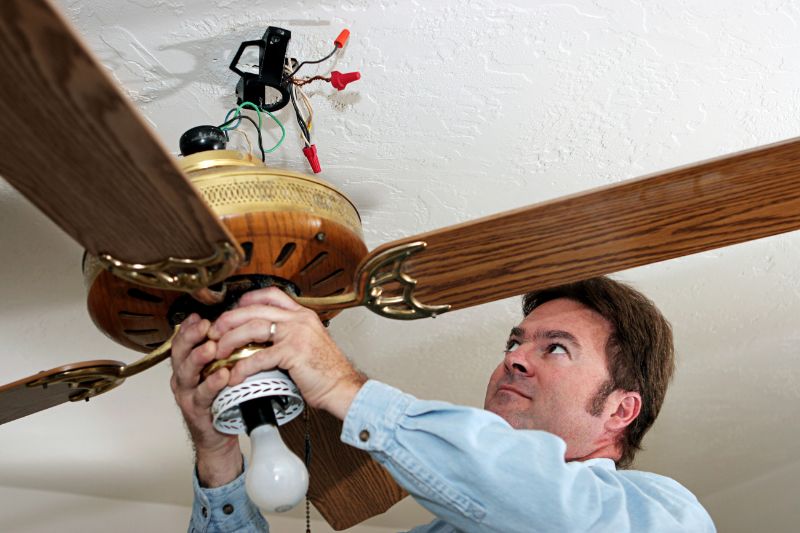No products in the cart.
Why You Hate Your Home’s Current Ceiling Fans

For decades, amateur home designers have taken down ceiling fans and replaced them with static light fixtures, falsely believing that ceiling fans do not fit into attractive and trendy home designs. The truth is that ceiling fans can be essential to creating a comfortable space, and many professional home designers understand how to integrate ceiling fans in ways that complement a home’s interior aesthetic.
If you can’t help but cringe when you see your home’s ceiling fans, you might need to consider that the problem is not with ceiling fans in general but with your fan, specifically. Here are a few issues that you might want to rectify before you decide to remove your ceiling fan entirely.
Your Fan Doesn’t Fit Your Style
More often than not, ceiling fans are something you inherit with your home, like kitchen appliances or backyard trees. Because ceiling fans require remarkably little maintenance, they can last for decades without demanding a replacement. On one hand, that means you don’t need to replace your ceiling fans until you have the budget to do so; on the other hand, it means that your ceiling fans could match the interior design style of previous homeowners — and clash with your own aesthetic.
Aside from replacing your current fans with ceiling fans that fit your style, there are a few things you can do to alter the look of your ceiling fans. You might consider:
- Replacing the blades with new blades of a different shape or color
- Painting the motor casing and/or blades
- Adding or removing a light kit
- Changing the bulbs or shades on the fan’s lights
Of course, if none of these alterations affect how you feel about your fan, you might need to start shopping for new models that more closely fit your current interior design.
Your Fan Is in the Wrong Location
There are strict rules for properly placing a ceiling fan in space — but not everyone follows them. You can find guidelines for sizing a fan to a space, and distances from walls and floors, and in doing so, you might notice that the reason your ceiling fans feel wrong is that they are breaking some or all of these rules.
Moving a ceiling fan can be difficult, but it isn’t impossible. If you don’t have much home renovation experience, you might want to hire a handyman for the job, as it involves cutting and patching drywall, moving electrical wiring, and other somewhat difficult tasks.
Your Fan Is Not Easy to Use
In the past, there were several ways to wire ceiling fans to increase their ease of use. Homeowners might have connected both the lights and the fan blades to different wall switches, ensuring easy and reliable access; they might have linked both elements to a single light switch or either lights or the fan blade to a switch. Then again, the easiest option is to wire none of the fans to a switch, meaning that to turn on the lights or to change the fan’s speed, you need to use the fixture’s unwieldy pull strings. If this is the issue in your home, you might be more than frustrated any time you need to change your fan’s settings.
Fortunately, this is one of the easiest problems on this list to fix. Creating a switch for your fan is a matter of changing the wiring in your home. You might want to hire a handyman or an electrician if you do not feel comfortable working with your home’s electrical system. Of course, if you want a remote control for your fan, you might need to replace your fan with a newer model.
Your Fan Is in Desperate Need of Maintenance
It is easy to hate a fan that squeaks or thumps while running, a fan that doesn’t maintain the speed setting you to want, or a fan that just simply never turns on. While fans are among the more durable home fixtures, they don’t run forever — especially if you or previous homeowners have not invested the time and effort to maintain them. Fan maintenance involves cleaning the fixture every few months to ensure dirt and grime doesn’t get into the motor; some fans might require periodic oiling, but only if the manual denotes it.
You might be able to rectify your problem by beginning a fan maintenance regimen today. You can deep-clean your fan, taking apart the motor housing and using cotton swabs to remove any traces of dirt and grime. Of course, for outdoor fans that are particularly susceptible to wear and tear, maintenance-related issues might not be resolved with a single cleaning, and you might consider replacing them with high-quality Hunter Fan outdoor ceiling fans that are more likely to last.
Don’t hate the idea of ceiling fans — figure out what is wrong with your ceiling fans and find a way to fix it. Ceiling fans are too useful in the home to do away with entirely, so if you can identify the true source of your ire, you will have a cohesive home design and energy efficiency.















Leave a Reply